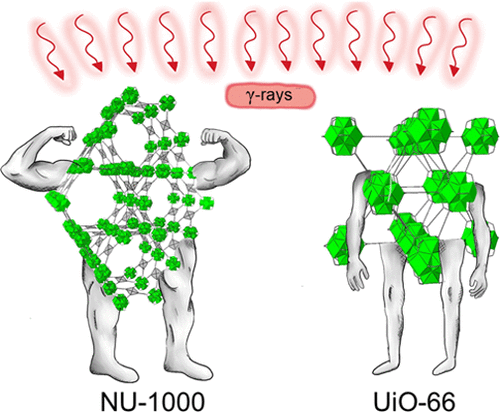当前位置:
X-MOL 学术
›
Ind. Eng. Chem. Res.
›
论文详情
Our official English website, www.x-mol.net, welcomes your
feedback! (Note: you will need to create a separate account there.)
Structural Features of Zirconium-Based Metal–Organic Frameworks Affecting Radiolytic Stability
Industrial & Engineering Chemistry Research ( IF 3.8 ) Pub Date : 2020-04-01 , DOI: 10.1021/acs.iecr.9b06820 Sylvia L. Hanna 1 , David X. Rademacher 2 , Donald J. Hanson 2 , Timur Islamoglu 1 , Alyssa K. Olszewski 1 , Tina M. Nenoff 2 , Omar K. Farha 1
Industrial & Engineering Chemistry Research ( IF 3.8 ) Pub Date : 2020-04-01 , DOI: 10.1021/acs.iecr.9b06820 Sylvia L. Hanna 1 , David X. Rademacher 2 , Donald J. Hanson 2 , Timur Islamoglu 1 , Alyssa K. Olszewski 1 , Tina M. Nenoff 2 , Omar K. Farha 1
Affiliation

|
Metal–organic frameworks (MOFs) NU-1000 and UiO-66 are herein exposed to two different gamma irradiation doses and dose rates and analyzed to determine the structural features that affect their stability in these environments. MOFs have shown promise for the capture and sensing of off-gases at civilian nuclear energy reprocessing sites, nuclear waste repositories, and nuclear accident locations. However, little is understood about the structural features of MOFs that contribute to their stability levels under the ionizing radiation conditions present at such sites. This study is the first of its kind to explore the structural features of MOFs that contribute to their radiolytic stability. Both NU-1000 and UiO-66 are MOFs that contain Zr metal-centers with the same metal absorption cross section. However, the two MOFs exhibit different linker connectivities, linker aromaticities, node densities, node connectivities, and interligand separations. In this study, NU-1000 and UiO-66 were exposed to high (423.3 Gy/min, 23 min, and 37 s) and low (0.78 Gy/min, 4320 min) dose rates of 60Co gamma irradiation. NU-1000 displayed insignificant radiation damage under both dose rates due to its high linker connectivity, low node density, and low node connectivity. However, low radiation dose rates caused considerable damage to UiO-66, a framework with lower aromaticity and smaller interligand separation. Results suggest that chronic, low-radiation environments are more detrimental to Zr MOF stability than acute, high-radiation conditions.
中文翻译:

锆基金属有机骨架的结构特征对辐射稳定性的影响
本文将金属有机骨架(MOF)NU-1000和UiO-66暴露于两种不同的伽马辐照剂量和剂量率下,并进行分析以确定影响其在这些环境中稳定性的结构特征。财政部已显示出有望在民用核能后处理场址,核废料处置库和核事故发生地点捕获和检测废气。但是,对于MOF的结构特征知之甚少,而这些结构特征在此类位置存在的电离辐射条件下会影响其稳定性。这项研究是探索MOF有助于其辐射稳定性的结构特征的同类研究中的第一项。NU-1000和UiO-66都是MOF,它们都包含具有相同金属吸收截面的Zr金属中心。然而,这两个MOF表现出不同的连接基连接性,连接基芳香性,节点密度,节点连接性和配体分离。在这项研究中,NU-1000和UiO-66暴露于高剂量(423.3 Gy / min,23 min和37 s)和低(0.78 Gy / min,4320 min)的剂量60 Coγ射线辐照。NU-1000在两个剂量率下均显示出微不足道的辐射损伤,这是由于其高连接子连接性,低节点密度和低节点连接性。然而,低辐射剂量率对UiO-66造成了相当大的损害,UiO-66是具有较低芳香性和较小配体间分离度的骨架。结果表明,慢性,低辐射环境比急性,高辐射条件更不利于Zr MOF稳定性。
更新日期:2020-04-24
中文翻译:

锆基金属有机骨架的结构特征对辐射稳定性的影响
本文将金属有机骨架(MOF)NU-1000和UiO-66暴露于两种不同的伽马辐照剂量和剂量率下,并进行分析以确定影响其在这些环境中稳定性的结构特征。财政部已显示出有望在民用核能后处理场址,核废料处置库和核事故发生地点捕获和检测废气。但是,对于MOF的结构特征知之甚少,而这些结构特征在此类位置存在的电离辐射条件下会影响其稳定性。这项研究是探索MOF有助于其辐射稳定性的结构特征的同类研究中的第一项。NU-1000和UiO-66都是MOF,它们都包含具有相同金属吸收截面的Zr金属中心。然而,这两个MOF表现出不同的连接基连接性,连接基芳香性,节点密度,节点连接性和配体分离。在这项研究中,NU-1000和UiO-66暴露于高剂量(423.3 Gy / min,23 min和37 s)和低(0.78 Gy / min,4320 min)的剂量60 Coγ射线辐照。NU-1000在两个剂量率下均显示出微不足道的辐射损伤,这是由于其高连接子连接性,低节点密度和低节点连接性。然而,低辐射剂量率对UiO-66造成了相当大的损害,UiO-66是具有较低芳香性和较小配体间分离度的骨架。结果表明,慢性,低辐射环境比急性,高辐射条件更不利于Zr MOF稳定性。











































 京公网安备 11010802027423号
京公网安备 11010802027423号